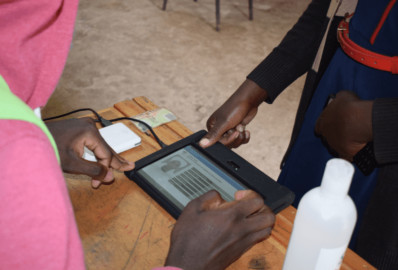Elections 2022: What you need to know about IEBC KIEMS kits

Facial image, fingerprints and civil data will be used to verify a voter’s identification at the polling station. | FILE

Audio By Vocalize
KIEMS - which will be used by the Independent Electoral and Boundaries Commission (IEBC) - has a biometric voter registration system that is used to electronically capture voters’ facial image, fingerprints and civil data.
This information will be used to verify a voter’s identification on Tuesday to curb impersonation.
The KIEMS kit also has a system that will enable presiding officers to transmit results to observation centres through specially configured mobile devices.
The mobile devices will aid the simultaneous transmission of tallied results to the constituency, county and national IEBC tallying centres.
Ahead of Tuesday's exercise, here are some of the things you should know about the IEBC’s KIEMS kits:
Some 55,100 KIEMS kits have been distributed nationally, according to the elections body.
The kits have high capacity internal batteries plus portable power banks capable of carrying it through the voting and transmission exercise.
“The KIEMS kit has an internal battery and two external batteries (power banks) that are fully charged before deployment. The three batteries have sufficient power to last beyond the voting and transmission period,” says IEBC.
While the KIEMS voter identification function is offline and does not require network connectivity, IEBC says the kits’ communication is encrypted and secured through 3G and 4G networks.
Each kit has two cards and in polling centres, network priority is given to IEBC's SIM cards.
“For purposes of electronic transmission of results, the KIEMS kit is fitted with both primary and secondary GSM sim cards to ensure continuity of the network in case one fails,” says IEBC.
For security of stored data, IEBC says the SD cards in the exercise are also contingency-encrypted. The kits also use digital signatures in the form of fingerprints to authenticate the identity of the Presiding Officer handling them.
Additionally, the kits use QR scanning to identify and validate election forms, which have been given pre-defined unique QR codes.
For backup purposes, each ward will get six additional KIEMS kits, as well as portable satellite modems.
This transmission system has been the centre of contention lately, with several lobby groups challenging the decision by IEBC to use the KIMS kit over a manual register.
They argued that technology is susceptible to attack and that voters may be disenfranchised in the event of technology failure.
After a court ruling, IEBC agreed to deploy printed registers alongside the KIEMS kits but, however, assured Kenyans of the security of the Results Transmission system.


Leave a Comment